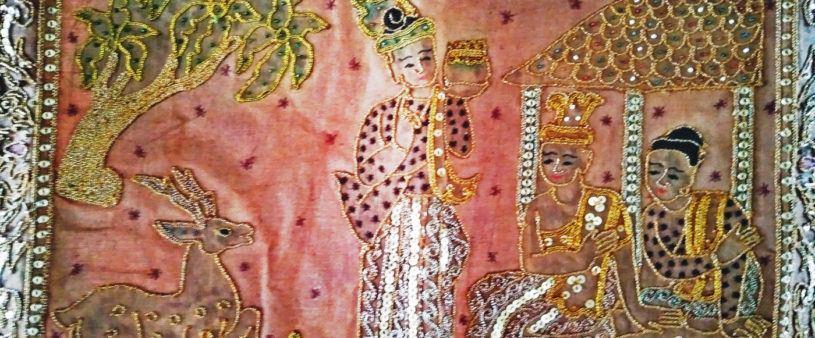The art of tapestry or “Shwe Chi Hto” (gold embroidery) as we call it. is said to have originated in Myanmar about a thousand years ago. It is a form of needlework to create a variety of pictures and patterns so delicate and detailed that it requires skill. artistry and patience. It is a highly decorative embroidery that employs gold thread as its name indicates. but in fact silver and colored threads as well as other materials such as tinsel,sequins, semi-precious gems, colorful cut glass, seed pearls and beads go into the making. The earliest record of such embroidery is the Pyu Period during the reign of King Mahayaza. circa AD 800.
The centre of this craft was and still is Mandalay,the long-standing hub of Myanmar culture and art. The ancient ceremonial royal raiment known as the “Maha Latta”,worn from time immemorial by kings and queens is a very heavy gold-embroidered and gem encrusted robe. The Maha Latta was worn by King Thibaw and Queen Suhpayalatt. the last reigning monarchs of Myanmar. Their robes were the creation of skilled seamstresses. goldsmiths and other artisans of Mandalay. These raiment are on display at the National Museum in Yangon.
The embroidery of gold thread and gems is so fine and intricate that it defies the imagination of an unskilled layman. The most outstanding artisans became court craftsmen by royal appointment. They sewed and embroidered all kinds of royal raiment for the monarch and the royal family. ministers and generals. from headgear down to footwear as well as other furnishings for the royal palace such as wall tapestry. fans. cushions. pillows and so forth.
The national ethnic groups also favor gold embroidered garments and headgear. The ceremonial dress and headgear of the Mon. Rakhine. Shan. Palaung. Kachin. Kayah. Padaung. Akhar and many others are heavily embroidered in gold and silver thread and encrusted with silver ornaments and beads. They are really gorgeous.
It takes a lot of time. practice and perseverance to become skilled in this decorative art of embroidery. To create an artistic piece of traditional Myanmar gold thread embroidery one needs a piece of white cloth of suitable proportions that has to be stretched and tightened on a square wooden frame. Then on the rigid and smooth surface the figures or patterns desired are sketched in outline with charcoal or pencil. In ancient times the basic design were floral patterns. vines and curlicues.

The sketched outlines are then stitched over with gold. silver or colored thread. This is the edging or border of the central picture of the embroidery. Then comes the ornaments that are sewed on such as silver stars. sequins. cut glass. beads and seed pearls to bring the picture to life. This part of the embroidery is called “ayoke cha gyin”. which literally means “laying down the figure”. Then the stitches are brushed over with glue on the underside to strengthen and prevent the threads from breaking. It also makes it easier to cut out the figures separately.
The cut figures or pictures are then appliquéd on the piece of velvet or satin or silk which will form the background of the embroidery. However an opening is left through which cotton is later stuffed to make an embossed figure. Then other adornments such as sequins. beads. seed pearls and semi-precious and even precious gems are added around the figure which is the central theme of the embroidery to form a backdrop.
Depending on the main figure or theme this backdrop could be a palace or a pond. a forest glade or a galaxy of stars or just patterns pleasing to the eye. Some of the more elaborate tapestries bring to life tales from the Jatakas. tales of velour and historic events. Sometimes a color painting or a patchwork of colored velvet is worked into the picture. Whatever it may be. it certainly requires great skill and artistry. The gem studded embroidery has to also call upon the work of gold and silver smiths. So a picturesque Myanmar tapestry is hardly the work of a single craftsman but a cooperative effort.
The patterns and names given to the small colored cut glass are equally fascinating. Some of them are called Diamond Dome. Rhomboid. Emerald Square and Banyan leaf. The sequins used in the embroidery for royal wear was made of genuine gold or silver and the artisans who made them lived in their own colony known as “Kyaikhat Win” as their descendants still do today. The ward where the gold embroidery is famous for is still known as “Shwechi Hto” ward to this day.In creating gold embroidery. the size. color. designs and patterns as well as the materials to be used depend on the object it is intended for. and in the days of the monarchy the place or person intended for.
A whole range of objects was adorned with gold and silver tapestries including monasteries and palaces. Some tapestries were used to adorn the ceiling of a shrine hall or used as room dividers and wall hangings in monasteries in palaces. Sometimes an entire wall would be hung with heavy tapestry. Other smaller objects such as fans were edged with gold embroidery. Then there were cushions and pillows and even palm leaf manuscripts that were ornamented with delicate gold embroidery. Royal crowns and coronets. headdresses and turbans. cuffs and sashes were embroidered with suitable insignia of rank and royalty. Other apparel for royalty were embroidered with pure gold thread and gems right down to the footwear. The harnesses and saddles of elephants and horses were also decorated with such embroidery for auspicious and ceremonial occasions.

The traditional designs and patterns were usually based on the Jataka tales and historic events or were depictions of celestial bodies and nature at different seasons of the year. There were also animals from elephants and lions to birds. Nowadays. Myanmar tapestry has become an attraction for tourists from abroad and there is a wide range of objects in gold embroidery. The traditional tapestries are still available but there are many eye-catching novelties like clutch purses. handbags. cushion covers and even baseball caps. But the basic figures and illustrations and the techniques remain about the same. Because of the huge popularity of Myanmar gold embroidered articles the previously small cottage industry has now spread to Yangon and other places. This has opened up employment opportunities for women with a skill and talent for needlework.
Thank you for reading!







